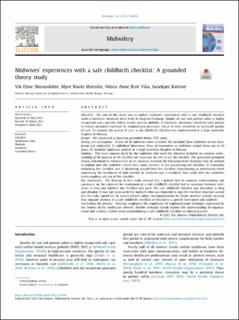| dc.description.abstract | Objective The aim of this study was to explore midwives’ experiences with a safe childbirth checklist used in handover situations from birth to hospital discharge. Quality of care and patient safety is highly recognised and a priority within health services globally. In handover situations, checklists have proven to reduce unwanted variation by standardising processes, which in turn contribute to increased quality of care. To improve the quality of care, a safe childbirth checklist was implemented at a large maternity hospital in Norway. Design We conducted a Glaserian grounded theory (GT) study. Setting and participants A total of 16 midwives were included. We included three midwives in one focus group and conducted 13 individual interviews. Years of experience as midwives ranged from one to 30 years. All included midwives worked in a large maternity hospital in Norway. Findings The main concern faced by the midwives who used the checklist included no common understanding of the purpose of the checklist nor consensus on how to use the checklist. The generated grounded theory, individualistic interpretation of the checklist, involved the following three strategies that all seemed to explain how the midwives solved their main concern: 1) not questioning the checklist, 2) constantly evaluating the checklist, and 3) distancing oneself from the checklist. Experiencing an unfortunate event concerning the healthcare of both mother or newborn was a condition that could alter the midwives understanding and use of the checklist. Key conclusions The findings in this study showed that a general lack of common understanding and consensus on the rationale for implementing a safe childbirth checklist led to variations between midwives in how and whether the checklist was used. The safe childbirth checklist was described as long and detailed. It was not necessarily the midwife who was expected to sign the checklist who had carried out the tasks signed for. To ensure patient safety, recommendations for future practice include securing that separate sections of a safe childbirth checklist are limited to a specific time-point and midwife. Implications for practice Findings emphasise the importance of implementation strategies supervised by the leaders of the healthcare services. Further research should explore the understanding of organisational and cultural context when implementing a safe childbirth checklist to clinical practice. | en_US |

